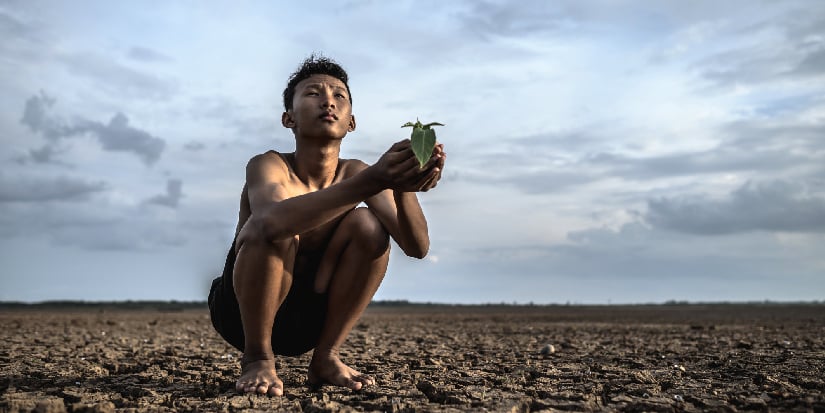 The Impact of Trees and Climate Change
The Impact of Trees and Climate Change
Climate change is a subject that triggers heated debate. With more and more people looking to embrace greener ways of living to protect the planet, it’s beneficial to evaluate trees’ importance. In this guide, we’ll explore the impact of trees on climate change.
How Do Trees Impact Climate Change?
Trees and climate change are inextricably linked. There is a crucial relationship between CO2 levels and tree cover. In recent history, the world has lost many thousands of kilometres of forests when emissions have increased due to industrial and commercial activities and changes in the way we live. Global warming is occurring at a frightening pace. The Intergovernmental Panel on Climate Change (IPCC) has issued a stark warning over rising temperatures. To save ecosystems and wildlife and protect against natural disasters, we need to restrict warming to a maximum of 1.5°. The temperature has already risen by 1°.
Climate change is a genuine threat, but how do trees impact climate change, and what role could they play in reducing temperatures and preserving the planet?
The most crucial function of trees is their ability to trap carbon. Woods, forests and jungles absorb carbon, storing it in trunks and removing carbon dioxide from the air. According to the Woodland Trust based in the UK, a wood comprising young trees will hold more than 400 tonnes of carbon per hectare. Estimates suggest that the world’s forests currently absorb around a third of the emissions we produce.
 The Potential of Planting
The Potential of Planting
A study conducted in Switzerland suggests that a global tree planting program could remove up to two-thirds of carbon generated by human activity. Researchers at ETH Zurich found that there are currently 1.7 billion treeless land hectares, which could hold up to 1.2 trillion saplings. The study’s findings appeared in the journal Science, and unsurprisingly, they have triggered debate and intrigue. According to the study, by planting over half a trillion trees, we could capture around 205 gigatons (a gigaton is equivalent to 1 billion metric tons) of carbon.
One of the most important factors to consider when examining the findings of studies like the ETH Zurich project is the driving forces behind climate change. The research team was keen to point out that planting trees is not a miracle cure. We must plant trees alongside a raft of other measures that work to reduce emissions. These include switching to renewable energy, using less energy, reducing waste and working towards national, international and global carbon net-zero targets.
 The Impact of Deforestation
The Impact of Deforestation
Deforestation is one of the most alarming contributors to accelerated global temperatures and increased natural disaster incidence. According to the United Nations’ Food and Agriculture Organization, currently, the world loses up to 7 million hectares of forests annually. The US alone has lost 90% of its indigenous forests since 1600. In the 21st century, 400 million hectares of woodland and forest were disturbed through natural disasters, including forest fires and flooding, or human activity, such as building, logging, creating new infrastructure or farming.
There are several reasons why deforestation has become prolific. Natural disasters have destroyed some forests, but human activity is the most common cause of losses. Humans now use the land to expand towns and cities, create new settlements, or convert it into agricultural land. People also cut down trees for commercial purposes, including logging and selling to manufacturers and corporations for industrial or construction purposes.
 Are Trees the Answer to Climate Change?
Are Trees the Answer to Climate Change?
Researchers worldwide are working on projects and innovations that could help prevent temperatures from rising, protect wildlife species, and preserve natural environments. Studies suggest that trees could have an incredibly positive impact on global warming, but planting is not the only solution. Reforestation and planting new trees could boost lower carbon dioxide levels, but initiatives run alongside additional measures.
One problem is that in some areas, trees are planted and then cut down and used for fuel, logs or building materials. The burning process releases more carbon, defeating the object of using trees to absorb carbon dioxide and store carbon.
Reforestation is not the same as new tree planting (known as aforestation), and it’s helpful to understand the difference between the two concepts when considering the benefits. Reforestation relates to planting in areas that used to be forests and woodland. In this case, saplings replace mature trees that were cut down, in most cases, for human use. Planting new trees is a means of expanding forests and identifying recent locations for young trees.
Research indicates a vast amount of space available on the earth to support new trees, and increasing planting could make a positive difference in the future.
 The Secondary Effects of Trees on Climate Change
The Secondary Effects of Trees on Climate Change
The most apparent benefit of trees is absorbing carbon dioxide and storing carbon. However, there are additional advantages to increasing the number of trees on the planet.
Trees do not just help reduce the risk of rising temperatures and carbon dioxide levels in the atmosphere. They also help to tackle the effects of climate change. Our changing climate poses risks to natural environments, as well as human health. As temperatures rise, there is an increased risk of flooding, changes in weather patterns, storms and hurricanes, drought and unpredictable conditions. Trees can help to combat these effects in several ways:
- Preventing flooding: trees provide canopy cover, which slows the speed of rainfall to the ground by intercepting drops. Some of the water droplets that leaves capture can evaporate into the air, reducing the amount of rain that reaches the ground. The root systems of trees also play an essential role. Roots encourage the soil to absorb water at a deeper level, meaning that less moisture reaches the surface, where it causes problems for people and businesses. Planting trees in urban areas can also reduce surface run-off, which is high in towns and cities due to the abundance of pathways, roads, paving, patios and driveways.
- Lowering temperatures in towns and cities: trees provide shade, reflect sunlight and facilitate evaporation, providing benefits in urban areas, which can be hot spots.
- Reducing pollution: the world’s forests absorb approximately one-third of emissions. Trees capture carbon dioxide, storing carbon as biomass and creating purer air for us to breathe. As emissions increase due to the way we live and population growth, trees play a vital role in decreasing pollution.
- Enhancing soil quality: high-quality soil is vital for farming, land management, healthy planting and growing and food production. Trees help improve soil quality as the roots increase water absorption and fallen leaves add vital nutrients to the soil.
 Useful Practice Guidelines for Planting and Reforestation
Useful Practice Guidelines for Planting and Reforestation
Planting trees could be an effective solution for reducing climate change risks and protecting the planet, but it is essential to plan, manage and implement planting and reforestation programmes effectively.
Planting trees is not as simple as choosing a spot, selecting a species and placing a sapling in the ground. Here are some useful practice guidelines for tree planting:
- Select trees that are suited to the conditions and local climate and environment. Planting trees in areas where they struggle to thrive could be counterproductive.
- Choosing locations that will not impact negatively upon existing ecosystems or wildlife.
- Mixing tree species to boost resilience against climatic conditions and pests.
- Ensuring forests have time to mature and develop. It can take decades for forests to fulfil their potential.
- Liaising and communicating with local populations and communities to understand what the project involves and why it is beneficial. In many cases, planting programmes are most successful when organizations join forces with local communities and volunteers.
- Managing the project effectively at every stage, from generating ideas and choosing locations to preserving natural habitats and wildlife and protecting the land.
Summary of the Impact of Trees and Climate Change
Climate change is a subject that dominates the headlines. More and more people are interested in protecting the planet and looking for ways to do their bit. Trees can make a hugely positive difference to the environment, but they are not a miracle cure for climate change. Trees absorb carbon dioxide and store vast amounts of carbon. Initiatives to replant forests and create new woodland areas can make a difference, but we must also implement and champion additional measures. These include using renewable energy, lowering energy consumption and embracing eco-friendly working, travelling and manufacturing goods. Planting more trees could increase carbon capture, but it’s essential to choose the right areas to plant or replant and select the right species based on the environmental conditions. Research related to the impact of trees on climate change is positive, and there is scope to benefit from creating new forests. If we do this simultaneously by adopting environmentally-friendly measures and working towards significant decreases in our carbon footprint, the future could look a lot brighter.







